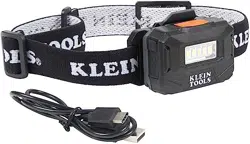Loading ...
Loading ...

2 3
GENERAL SPECIFICATIONS
Klein Tools’ ET160 is an easy-to-use tester that provides audible and
visual alarms in the presence of CFC’s, HFC’s, HCFC’s and blends. Detect
as low as 100 ppm of common refrigerant gases.
• Audible Alert: 85 db ticking, modulation proportional to gas
concentration
• Visual Alert: 5× blue LED,
illumination proportional to gas concentration
• Range*: 100 to 3,000 ppm
LOW sensitivity* (white light): 200 to 3,000 ppm
HIGH sensitivity* (yellow light): 100 to 1,000 ppm
• Initial calibration: 50 seconds to zero calibration
• Response time (after calibration): 3 seconds
• Sensor: Heated diode
• Sensor Life expectancy: 5 years
• Probe: 18" (457 mm) gooseneck
• Batteries: 4× AAA alkaline
• Operating Altitude: 6562 ft. (2000 m)
• Relative Humidity: <80% non-condensing
• Operating Temp: 32° to 122°F (0° to 50°C)
• Storage Temp: -4° to 122°F (-20° to 50°C)
• Dimensions: 8.11" × 2.72" × 1.75" (206 × 69 × 45 mm)
• Weight: 15 oz. (425 g) including batteries
• Tripod Mount: 1/4-20 UNC
• Drop Protection: 6.6 ft. (2m)
• Standards: EN14624:2020
*Based on R-134A. Other gases or mixtures will have different values.
Specifications subject to change.
WARNINGS
To ensure safe operation and service of the tester, follow these
instructions. Failure to observe these warnings can result in severe
injury or death. Know the characteristics of the gas you are working
with and use proper precautions to avoid hazardous conditions.
• Read, understand, and follow all instructions to ensure safe operation.
• Always turn on the gas detector in an area known to be free of gases.
• Initial calibration should be performed in an area known to be free of
refrigerant gases. Calibration in an area containing refrigerant gas will
result in incorrect calibration and lower than actual readings. This could
result in refrigerant gases not being detected.
• The refrigerant gas leak detector is NOT intended as a personal protection
device (PPE).
• The refrigerant gas leak detector is NOT insulated. Avoid contact with areas
where energized conductive elements may be present. Shut off power to
the area before starting measurements.
• Do NOT probe moving machinery that could catch any part of the meter
and cause harm to the operator and the meter.
• Always wear approved eye protection.
FEATURE DETAILS
NOTE: There are no user-serviceable parts inside tester.
1.
Gooseneck
9.
Auto Power-Off (APO) Button
2.
Gooseneck Clip
10.
LOW Sensitivity Mode Button
3.
Sensor Head
11.
HIGH Sensitivity Mode Button
4.
Indicator Lights
12.
HOLD Button
5.
LOW Sensitivity Light
13.
Power Button
6.
HIGH Sensitivity Light
14.
1/4-20 UNC Tripod Mount
7.
Auto-Zero Button
15.
Battery Door
8.
Mute Button
16.
Battery Cartridge (inside battery compartment)
ENGLISH
Front of
Tester
Back of
Tester
1
5
8
7
10
13
11
12
6
9
4
16
2
14
15
3
Loading ...
Loading ...
Loading ...
